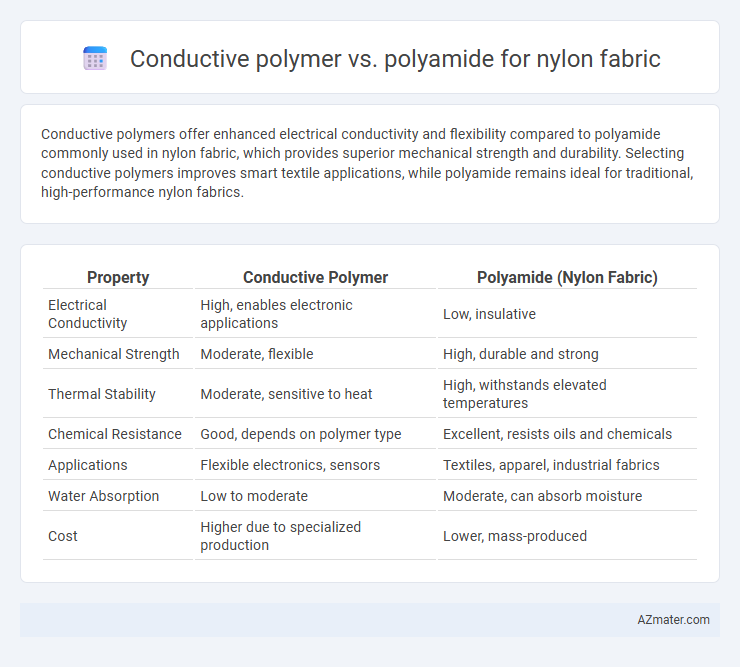Conductive polymers offer enhanced electrical conductivity and flexibility compared to polyamide commonly used in nylon fabric, which provides superior mechanical strength and durability. Selecting conductive polymers improves smart textile applications, while polyamide remains ideal for traditional, high-performance nylon fabrics.
Table of Comparison
| Property | Conductive Polymer | Polyamide (Nylon Fabric) |
|---|---|---|
| Electrical Conductivity | High, enables electronic applications | Low, insulative |
| Mechanical Strength | Moderate, flexible | High, durable and strong |
| Thermal Stability | Moderate, sensitive to heat | High, withstands elevated temperatures |
| Chemical Resistance | Good, depends on polymer type | Excellent, resists oils and chemicals |
| Applications | Flexible electronics, sensors | Textiles, apparel, industrial fabrics |
| Water Absorption | Low to moderate | Moderate, can absorb moisture |
| Cost | Higher due to specialized production | Lower, mass-produced |
Introduction to Conductive Polymers and Polyamide
Conductive polymers, such as polyaniline and polythiophene, offer electrical conductivity combined with the flexibility and durability of plastics, making them suitable for advanced functional textiles. Polyamides, primarily known as Nylon, are synthetic polymers characterized by strong intermolecular hydrogen bonds, imparting high tensile strength, abrasion resistance, and elasticity to fabrics. While polyamide fibers dominate in traditional nylon fabric applications, integrating conductive polymers introduces new possibilities for wearable electronics and smart textile innovations.
Chemical Structure Comparison
Conductive polymers, such as polyaniline and polypyrrole, feature conjugated p-electron backbones that enable electrical conductivity, contrasting with polyamide (nylon), which possesses amide linkages (-CONH-) within a non-conjugated aliphatic backbone. The chemical structure of polyamide consists of repeating units derived from diamines and dicarboxylic acids, forming strong hydrogen bonds that enhance mechanical strength and durability but lack intrinsic conductivity. Conductive polymers incorporate delocalized electrons through alternating single and double bonds, providing unique electronic properties absent in the standard polyamide framework.
Electrical Conductivity: Key Differences
Conductive polymers exhibit significantly higher electrical conductivity compared to polyamide used in traditional nylon fabrics, making them ideal for smart textile applications. Polyamide fibers have inherently low electrical conductivity, limiting their use in electronic textiles without additional conductive treatments or coatings. The integration of conductive polymers into nylon fabrics enhances the material's ability to transmit electrical signals, enabling advanced functionalities such as wearable sensors and flexible electronics.
Mechanical Properties and Durability
Conductive polymers exhibit enhanced flexibility and tensile strength compared to traditional polyamide fibers used in nylon fabrics, offering superior mechanical properties ideal for wearable electronics. Polyamide fibers provide robust durability, excellent abrasion resistance, and high elasticity, ensuring long-lasting performance in demanding textile applications. The integration of conductive polymers into nylon fabric significantly improves electrical conductivity without compromising the inherent mechanical strength and durability of polyamide materials.
Thermal Stability and Heat Resistance
Conductive polymers typically exhibit lower thermal stability and heat resistance compared to polyamide-based nylon fabrics, which are engineered for high-temperature applications with melting points around 215-265degC. Polyamide fibers maintain structural integrity and mechanical performance under prolonged heat exposure, making them suitable for thermal-resistant textiles. In contrast, conductive polymers often degrade or lose conductivity at elevated temperatures, limiting their use in heat-intensive environments.
Fabric Performance in Textile Applications
Conductive polymers enhance Nylon fabric performance by providing excellent electrical conductivity and flexibility, making them ideal for smart textiles and wearable technology. Polyamide-based Nylon fabrics offer high tensile strength, abrasion resistance, and moisture-wicking properties, ensuring durability and comfort in activewear and industrial applications. Integrating conductive polymers into polyamide Nylon combines durability with advanced functionality, optimizing fabric performance for innovative textile applications.
Advantages of Conductive Polymer-Infused Nylon
Conductive polymer-infused nylon offers enhanced electrical conductivity, enabling smart textile applications such as wearable sensors and flexible electronics. This integration improves durability and maintains the fabric's lightweight and flexible properties, unlike traditional polyamide nylon which lacks inherent conductivity. Additionally, conductive polymers provide improved moisture management and antimicrobial properties, enhancing overall fabric performance.
Limitations of Polyamide in Conductive Fabrics
Polyamide, commonly used in Nylon fabrics, exhibits inherent limitations in conductive applications due to its poor electrical conductivity and susceptibility to moisture absorption, which degrades conductivity over time. Its relatively high water absorption increases dielectric losses and reduces the efficiency of conductive pathways in fabric composites. Additionally, polyamide's mechanical flexibility can be compromised when integrating conductive fillers, leading to reduced durability and compromised textile performance.
Cost and Manufacturing Considerations
Conductive polymers offer innovative electrical properties but typically involve higher raw material and processing costs compared to polyamide fibers used in nylon fabric production. Polyamide manufacturing benefits from established, cost-efficient methods like melt spinning and extrusion, resulting in large-scale production with consistent quality and lower price points. While conductive polymers may require specialized equipment and longer production cycles, polyamide's versatility and scalability make it more economical for conventional nylon fabric applications.
Future Trends in Nylon Fabric Technologies
Conductive polymers integrated into nylon fabrics enable advanced functionalities such as wearable electronics, enhanced electrical conductivity, and smart textile applications. Polyamide-based nylon remains favored for its strength, durability, and moisture-wicking properties, but future trends highlight hybrid materials combining polyamide with conductive polymers to achieve flexible, lightweight, and multifunctional fabrics. Innovations in nanotechnology and flexible electronics will drive the development of nylon fabrics that offer improved performance in health monitoring, energy harvesting, and responsive clothing systems.

Infographic: Conductive polymer vs Polyamide for Nylon fabric
 azmater.com
azmater.com